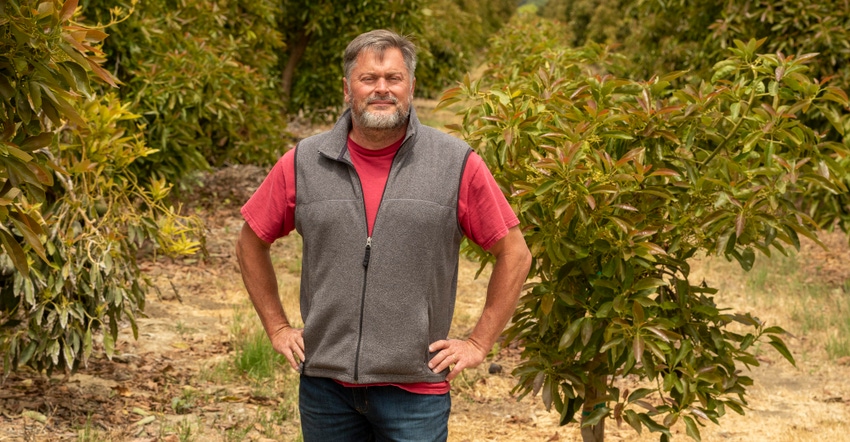
Coastal California lemon and avocado growers know well the challenges of climate change and foreign competition. Nevertheless, agricultural output in Ventura County grosses about $2 billion annually.
Avocados from Mexico and Argentine lemons are having mixed results for growers like Chris Sayer of Santa Paula, Calif.
The Argentine citrus is said to be coming in at prices under the cost of production for U.S. growers, particularly those in California where the cost of production tends to run higher than elsewhere in the U.S. Moreover, it is said that it costs less to ship lemons from South America to East Coast ports than it does to truck them cross-country.
Mexican avocado imports are having their fiscal effects too, but in a surprising way. The Avocados from Mexico marketing campaign is boosting consumer demand which U.S. growers are eager to fill.
"The interesting thing is, as the Mexican imports came on, it actually built demand and California domestic producers didn't have to work as hard to build demand at the beginning of the season," Sayer said. "Overall consumption continues to rise. American avocado consumption went from about a pound per capita in the mid-1990s to over eight pounds per capita today."
Another benefit to the large Mexican avocado crop is the stabilization of price. Because avocados alternate bear – heavy crops one year and a lighter crop the next – the price swings would cause growers to grumble during those "on" year heavy crops as prices tanked.
"Any grower over 70 years old will tell you about the time he got $2 per pound, but what they don't tell you is the following year they got 17 cents," Sayer continues.
With the larger Mexican crop and higher demand, California's production no longer distorts the market, he said. Because of this, avocado prices have generally stabilized to about $1.20 per pound to the grower, he said.
Climate change
Wind events that used to be exclusive to October in his region now can come in the winter and spring, he said. Hot temperatures unheard of in year's past are now happening. Temperatures late last summer climbed to 120 degrees along Sayer's stretch of the California coast.
Hurricane-force winds for about 24 hours in January, coupled with low humidity, punished his maturing avocado crop, and scarred the young lemons.
Sayer is a fifth-generation farmer in the Santa Paula and Saticoy area of Ventura County. His acreage is evenly split between avocados and lemons. He said that split will begin to favor avocados in the next few years as he removes some older lemons and replaces them with avocados.
The avocados tend to have one long harvest cycle spread across several months, he said. Fruit will be picked based on size. The trees are evergreen and will have two crops on them at any one time.
An insect battle
Sayer chairs the board of directors for the nearby Associates Insectary, a cooperative that rears beneficial insects used in nearby cropping systems. He is keenly aware of the tiny Asian citrus psyllid, a nemesis of the California citrus industry and an insect responsible for decimating Florida's citrus production because of the disease it vectors.
Though beneficial insects exist to parasitize the Asian citrus psyllid, they can be somewhat effective in controlling psyllids if ants are not present. Otherwise, the tiny Tamarixia radiata wasp is completely ineffective.
Sayer works with his neighbors and the California Department of Food and Agriculture's citrus program to coordinate timed insecticide sprays for the Asian citrus psyllid in his area. Those costs add up quickly when trying to compete in a global marketplace for lemons.
Sayer is also working to plant newer lemon varieties that can produce top-grade fruit.
"Any second-grade or smaller fruit and the price just drops off," he said. "We're aggressively replanting younger trees in here and treating to prevent insect damage."
Aside from the ACP, beneficial insects exist to help control other citrus pests that can be troublesome to growers.
County agriculture portfolio
Ventura County quietly ranks in the top-10 of agricultural counties in the state. Ventura's avocado crop in 2019 was valued at nearly $117 million, according to the annual crop report published by Ventura County.
California produces about 95% of the U.S. avocado crop within two counties – San Diego and Ventura. The state's avocado growers produced 171,000 tons in 2018, according to the California Department of Food and Agriculture.
Likewise, California produces about 95% of the U.S. lemon crop. Outside of Ventura County, much of that fruit is grown in the Central Valley. Over 950,000 tons of lemons was produced in California in 2018.
Sayer says Ventura County's ranking, while significant, tends to be ignored on a political level and as such, growers who produce fruits and vegetables in the region don't receive positive attention other parts of the state or country receive during agricultural policy discussions.
"We're a $2 billion ag economy here," he said. "In any other state we would be a golden child and fawned over. When the federal government thinks of ag policy they think of Iowa, and they think of corn and pork; when California thinks of ag policy they think of things like rice, almonds, and wine grapes. So here we are a huge and very important county, agriculturally speaking, and nobody pays attention to it."
Sayer's family has farmed in California since the late 19th Century. What started in walnuts transitioned to sugar beets before making the move to citrus and avocados. He works with Cooperative Extension scientists to understand new varieties and orchard spacing studies to maximize his profitability. Sayer is active on social media and can be found on Twitter @pettyranch.
About the Author(s)
You May Also Like






